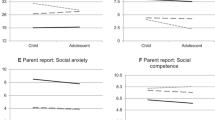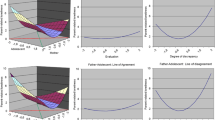Abstract
Perceived loneliness and social competence were assessed for 127 children with ASD without comorbid ID, 4–7 years old, through child self-report. Using an abbreviated version of the Loneliness and Social Dissatisfaction Questionnaire (LSDQ; Cassidy and Asher in Child Dev 63:250–365, 1992), the majority of children reported friendships, yet a considerable proportion also reported social difficulties. Factor analysis of the abbreviated LSDQ identified three factors, which were significantly associated with parent- and teacher-reported variables. Regression analyses revealed parent-reported social skills deficits and teacher-reported conflict in the student–teacher relationship to be associated with child-reported loneliness. Implications for practice are discussed.
Similar content being viewed by others
References
Achenbach, T. M. (2000). Manual for the child behavior checklist 1½–5. Burlington: University of Vermont.
Achenbach, T. M., & Rescorla, L. A. (2001). Manual for the ASEBA school-age forms and profiles. Burlington: University of Vermont.
Asher, S. R., Hymel, S., & Renshaw, P. D. (1984). Loneliness in children. Child Development, 55, 1456–1464.
Bauminger, N., & Kasari, C. (2000). Loneliness and friendship in high-functioning children with autism. Child Development, 71, 447–456.
Bauminger, N., Shulman, C., & Agam, G. (2004). The link between perceptions of self and of social relationships in high-functioning children with autism. Journal of Development and Physical Disabilities, 16, 193–214.
Bauminger, N., Solomon, M., & Rogers, S. J. (2010). Predicting friendship quality in autism spectrum disorders and typical development. Journal of Autism and Developmental Disorders, 40, 751–761.
Bishop, D. V. M. (2006). Children’s Communication Checklist (2nd ed., U.S. ed.). San Antonio, TX: Psychological Corporation.
Blacher, J., Baker, B. L., & Eisenhower, A. S. (2009). Student–teacher relationship stability across early school years for children with intellectual disability or typical development. American Journal on Intellectual and Developmental Disabilities, 114, 322–339.
Blacher, J., Howell, E., Lauderdale-Littin, S., DiGennaro Reed, F. D., & Laugeson, E. A. (2014). Autism spectrum disorder and the student teacher relationship: A comparison study with peers with intellectual disability or typical development. Research in Autism Spectrum Disorders, 8, 324–333.
Cappadocia, M. C., Weiss, J. A., & Pepler, D. (2011). Bullying experiences among children and youth with autism spectrum disorders. Journal of Autism and Developmental Disorders, 42, 266–277.
Cassidy, J., & Asher, S. R. (1992). Loneliness and peer relations in young children. Child Development, 63, 250–365.
Chamberlain, B., Kasari, C., & Rotheram-Fuller, E. (2007). Involvement or isolation? The social networks of children with autism in regular classrooms. Journal of Autism and Developmental Disorders, 37, 230–242.
Constantino, J. N., & Gruber, C. P. (2005). The Social Responsiveness Scale. Los Angeles, CA: Western Psychological Services.
Eisenhower, A., Blacher, J., & Bush, H. (2015). Longitudinal associations between externalizing problems and student–teacher relationship quality for young children with ASD. Research in Autism Spectrum Disorders, 9, 163–173.
Falkmer, M., Parsons, R., & Mats, G. (2012). Looking through the same eyes? Do teachers’ participation ratings match with rating of students with autism spectrum conditions in mainstream schools? Autism Research and Treatment, 2012, 1–13.
Gresham, F. M., & Elliott, S. N. (2008). Social skills rating system. Circle Pines, MN: American Guidance Service.
Hollingsworth, H. L., & Buysse, V. (2009). Establishing friendships in early childhood inclusive settings: What roles do parents and teachers play? Journal of Early Intervention, 31(4), 287–307.
Howes, C. (2000). Social-emotional classroom climate in child care, child–teacher relationships, and children’s second grade peer relationships. Social Development, 9, 191–204.
Howlin, P., Goode, S., Hutton, J., & Rutter, M. (2004). Adult outcome for children with autism. Journal of Child Psychology and Psychiatry, 42, 212–229.
Hughes, J. N., & Kwok, O. (2006). Classroom engagement mediates the effect of teacher–student support on elementary students’ peer acceptance: A prospective analysis. Journal of School Psychology, 43(6), 465–480.
IBM Corp. (2013). IBM SPSS statistics for windows, version 22.0. Armonk, NY: IBM Corp.
Johnson, S. A., Filliter, J. H., & Murphy, R. R. (2009). Discrepancies between self- and parent-perceptions of autistic traits and empathy in high functioning children and adolescents on the autism spectrum. Journal of Autism and Developmental Disorders, 39, 1706–1714.
Kalyva, E. (2010). Multirater congruence on the social skills assessment of children with Asperger syndrome: Self, mother, father, and teacher ratings. Journal of Autism and Developmental Disorders, 40, 1202–1208.
Kasari, C., Locke, J., Gulsrud, A., & Rotheram-Fuller, E. (2011). Social networks and friendships at school: Comparing children with and without ASD. Journal of Autism and Developmental Disorders, 41, 533–544.
Kato, K., Mikami, K., Akama, F., Yamada, K., Maehara, M., Kimoto, K., et al. (2013). Clinical features of suicide attempts in adults with autism spectrum disorders. General Hospital Psychiatry, 35(1), 50–53.
LaFreniere, P., & Dumas, J. E. (1995). Social competence and behavior evaluation (SCBE). Torrance, CA: Western Psychological Services.
Lasgaard, M., Nielsen, A., Eriksen, M. E., & Goossens, L. (2010). Loneliness and social support in adolescents with autism spectrum disorders. Journal of Autism and Developmental Disorders, 40, 218–226.
Laws, G., Bates, G., Feuerstein, M., Mason-Apps, E., & White, C. (2012). Peer acceptance of children with language and communication impairments in a mainstream primary school: Associations with type of language disability, problem behaviours and a change in placement organization. Child Language Teaching and Therapy, 28, 73–86.
Lord, C., Risi, S., Lambrecht, L., Cook Jr, E. H., Leventhal, B. L., DiLavore, P. C., et al. (2000). The Autism Diagnostic Observation Schedule—Generic: A standard measure of social and communication deficits associated with the spectrum of autism. Journal of autism and developmental disorders, 30(3), 205–223.
Lord, C., Rutter, M., & Le Couteur, A. (1994). Autism Diagnostic Interview-Revised: a revised version of a diagnostic interview for caregivers of individuals with possible pervasive developmental disorders. Journal of autism and developmental disorders, 24(5), 659–685.
Lyons, J., Cappadocia, M. C., & Weiss, J. A. (2011). BRIEF REPORT: Social characteristics of students with autism spectrum disorders across classroom settings. Journal on Developmental Disabilities, 17(1), 77–82.
Macintosh, K., & Dissanayake, C. (2006). Social skills and problem behaviors in school aged children with high-functioning autism and Asperger’s disorder. Journal of Autism and Developmental Disorders, 36, 1065–1076.
Matson, J. L., & Nebel-Schwalm, M. (2007). Assessing challenging behaviors in children with autism spectrum disorders: A review. Research in Developmental Disabilities, 28, 567–579.
Mayes, S. D., Gorman, A. A., Hillwig-Garcia, J., & Syed, E. (2013). Suicide ideation and attempts in children with autism. Research in Autism Spectrum Disorders, 7(1), 109–119.
Mazurek, M. O., & Kanne, S. M. (2010). Friendship and internalizing symptoms among children and adolescents with ASD. Journal of Autism and Developmental Disorders, 40, 1512–1520.
Odom, S. L., McConnell, S. R., & Brown, W. H. (2008). Social competence of young children: Conceptualization, assessment, and influences. In W. H. Brown, S. L. Odom, & R. R. McConnell (Eds.), Social competence of young children: Risk, disability, and intervention (pp. 3–29). Baltimore: Paul H. Brookes Publishing Co.
Pianta, R. C. (2001). Student–teacher relationship scale: Professional manual. Odessa, FL: Psychological Assessment Resources Inc.
Pianta, R. C., & Stuhlman, M. W. (2004). Teacher–child relationships and children’s success in the first years of school. School Psychology Review, 33, 444–458.
Raykov, T., & Marcoulides, G. A. (2008). An introduction to applied multivariate analysis. New York: Routledge.
Reichow, B., & Volkmar, F. R. (2010). Social skills intervention for individuals with autism: Evaluations for evidence-based practices within a best evidence synthesis framework. Journal of Autism and Developmental Disorders, 40, 149–166.
Robertson, K., Chamberlain, B., & Kasari, C. (2003). General education teachers’ relationships with included students with autism. Journal of Autism and Developmental Disorders, 33, 123–130.
Rotheram-Fuller, E., Kasari, C., Chamberlain, B., & Locke, J. (2010). Social involvement of children with autism spectrum disorders in elementary school classrooms. Journal of Child Psychology and Psychiatry, 51, 1227–1234.
Sattler, J. M., & Dumont, R. (2004). Assessment of children: WISC-IV and WPPSI-III supplement. San Diego, CA: Jerome M. Sattler Publishing Company.
Snow, A. V., & Lecavalier, L. (2011). Comparing autism, PDD-NOS, and other developmental disabilities on parent-reported behavior problems: Little evidence for ASD subtype validity. Journal of Autism and Developmental Disorders, 41, 302–310.
Storch, E. A., Larson, M. J., Ehrenreich-May, J., Arnold, E. B., Jones, A. M., Renno, P., et al. (2012). Peer victimization in youth with autism spectrum disorders and co-occurring anxiety: Relations with psychopathology and loneliness. Journal of Developmental and Physical Disabilities, 24, 575–590.
Strain, P. S., Schwartz, I. S., & Bovey, E. H, I. I. (2008). Social competence interventions for young children with autism. In W. H. Brown, S. L. Odom, & R. R. McConnell (Eds.), Social competence of young children: Risk, disability, and intervention (pp. 253–272). Baltimore: Paul H. Brookes Publishing Co.
Troop-Gordon, W., & Kopp, J. (2011). Teacher–child relationship quality and children’s peer victimization and aggressive behavior in late childhood. Social Development, 20, 536–561.
Wainscot, J. J., Naylor, P., Sutcliffe, D. T., & Williams, J. V. (2008). Relationship with peers and use of the school environment of mainstream secondary school pupils with Asperger syndrome (high-functioning autism): A case–control study. International Journal of Psychology and Psychological Therapy, 8(1), 25–28.
Wechsler, D. (2002). WPPSI-III technical and interpretation manual. San Antonio, TX: Psychological Corporation.
White, K. J., & Jones, K. (2000). Effects of teacher feedback on the reputations and peer perceptions of children with behavior problems. Journal of Experimental Child Psychology, 76, 302–326.
White, S. W., & Roberson-Nay, R. (2009). Anxiety, social deficits, and loneliness in youth with autism spectrum disorders. Journal of Autism and Developmental Disorders, 39, 1006–1013.
Zeedyk, S. M., Rodriguez, G., Tipton, L. A., Baker, B. L., & Blacher, J. (2014). Bullying of youth with autism spectrum disorder, intellectual disability, or typical development: Victim and parent perspectives. Research in Autism Spectrum Disorders, 8, 1173–1183.
Acknowledgments
This paper was based on a longitudinal study funded by the Institute of Education Sciences (R324A110086; J. Blacher, P.I.). Support was also provided by the SEARCH Family Autism Resource Center in the Graduate School of Education, UC Riverside. We are indebted to our colleagues and students and to the children, parents, and teachers who participated in this research.
Author Contributions
SZ developed the idea for this study, which was based on an ongoing longitudinal project [IES, R324A110086, Jan Blacher, PI], participated in its implementation, including data collection, analysis, and all aspects of manuscript preparation; SC participated in the data collection and interpretation; AE, as co-PI, reviewed the manuscript; JB conceived of the study and design, directed study implementation, and participated in interpreting the data and drafting the manuscript. All authors read and approved the final manuscript.
Author information
Authors and Affiliations
Corresponding author
Rights and permissions
About this article
Cite this article
Zeedyk, S.M., Cohen, S.R., Eisenhower, A. et al. Perceived Social Competence and Loneliness Among Young Children with ASD: Child, Parent and Teacher Reports. J Autism Dev Disord 46, 436–449 (2016). https://doi.org/10.1007/s10803-015-2575-6
Published:
Issue Date:
DOI: https://doi.org/10.1007/s10803-015-2575-6




